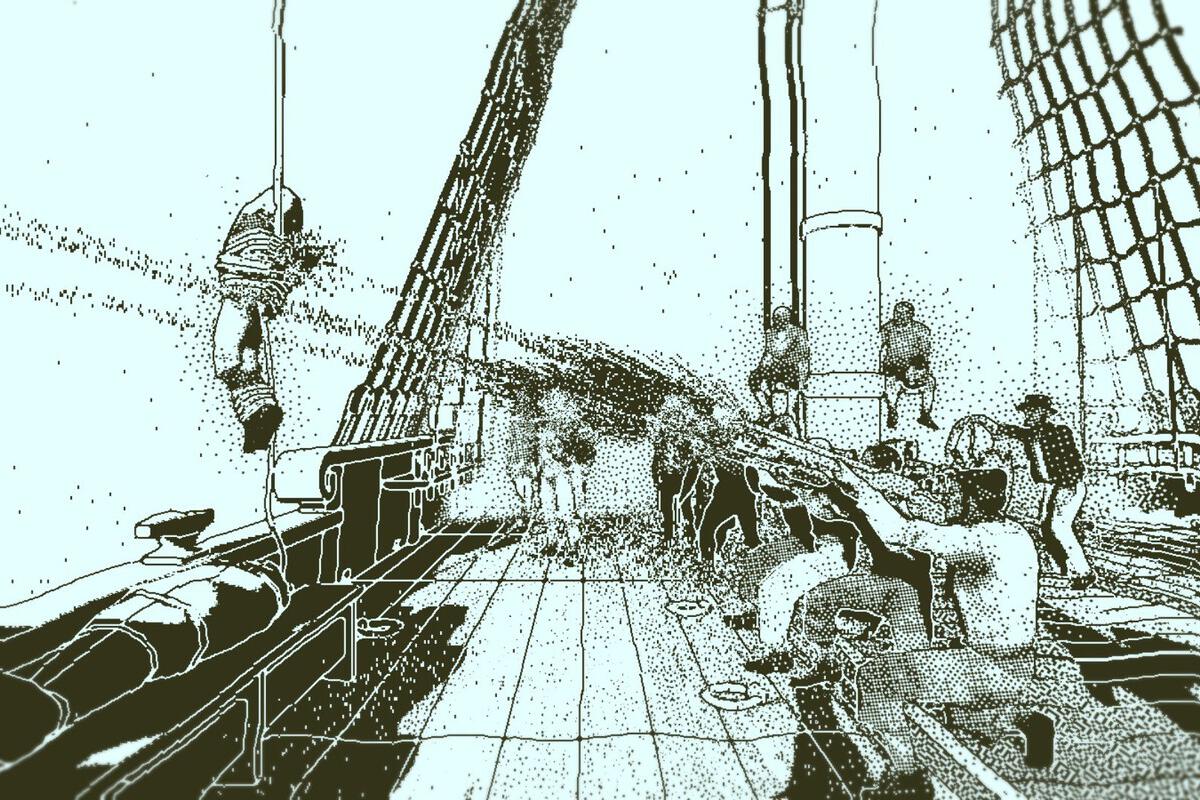
Return of the Obra Dinn is a deduction game. It describes itself as an insurance adventure, which is a very literal description; you are an insurance assessor, and journey one stormy evening to the good ship Obra Dinn, which has mysteriously reappeared after five years lost at sea. There are no evident survivors. It’s your job to complete a report chronicling the fate of everybody on board. To do so, you use a magic pocket watch called the Memento Mortem. When ‘activated’ near a corpse, the watch will replay the last few things they heard, and show you a still-life diorama of the location and moment of their death.
For example, I approach a disembodied arm, and I ‘use’ the watch on it. I hear a scuffle, some clashes of steel, a meaty slicing sound, then gurgling cries dying down to a whimper. I then see a diorama of a passenger lying on the ground armless, in their moment of death, and perhaps also see a scimitar-wielding sailor stood over them, wide-eyed. From this, I deduce that the sailor killed the passenger. I open my journal, into which I must enter a) the victim’s identity, b) their mode of death, and c) their killer via a set of three multiple-choice fields.
Some modes of death preclude a killer, such as suicide or accident, but most ‘fates’, as the game calls them, require these three components. The only problem is, I don’t know the names of either character. But I have a few unlabelled drawings of the crew, and also the ship’s crew manifest, which gives me the names, nationalities, and titles (such as second mate, midshipman, or passenger) of everyone who was aboard. So, since the mode of death is usually obvious (in this case, I select ‘was killed with a sword’), the real puzzle lies in identifying the souls who embarked on this cursed voyage.
IDENTIFICATION
So, it’s thinking time. Let’s say that, as another individual expires of flu, I hear “Roll the dice, Eddie!” yelled in the background. When I look around in his moment of death, I notice a man with dice in his hand and a scimitar on his hip. I’ve not seen anyone else with a scimitar, and there’s only one ‘Edward’ on the crew manifest! Maybe I also see the passenger, sketching in a notebook. Is he, in fact, not a passenger, but the ship’s artist, Giorgio? I select this combination in my book: a) Giorgio b) was killed with a sword by c) Edward.
Ding ding! That’s correct. But, when my deductions are true, the game doesn’t always verify its accuracy straight away. If it did, I could simply sit and try every combination of names, or at least if I knew one of these characters’ names but not the other, I could click through the others until the game verified the correct answer. Instead, Obra Dinn verifies fates in sets of three at a time. It’s the rule of three: as soon as three deaths have been accurately logged, the game pulls me out of the action and lets me know that they were correct, stamping them permanently into the insurance ledger.

MementoYou never know where the watch will take you, as many aboard died somewhere other than their final resting place.
EVALUATION
This is an elegant way of dealing with the issue of player solution input in deductive games, and Obra Dinn’s is nearly there. The multiple-choice lists are extensive enough to not be too restrictive, although the list items give away some broader thematic clues. And waiting until you get three sets of three-part entries precisely correct prevents most brute-force verification. But the rule of three mechanic does still lead, in my own and every playthrough I’ve seen online, to a reasonable amount of blindly fishing for answers. Since any three fates can be verified together, every time a verification occurs, you know for sure that any fate you’ve entered but which didn’t get verified is incorrect. Once you learn this, you can use it to cycle between possible answers to the incorrect fates.
One such example which seems to be very common in people’s playthroughs is regarding the identities of the Chinese sailors. Let’s say we see a sailor clearly being crushed by falling rigging. He spoke a Chinese language in the moments before his death, so you can quickly guess that he’s one of the four Chinese aboard. But they never refer to each other by name. So you take a stab, perhaps selecting ‘Huang Li’, first in the list. A little later, three other fates are verified, but not this one, so you know the crushed man isn’t Li and you instead change the name to ‘Jie Zhang’. More are verified, and still no luck. So you change it to ‘Ban Lim’. Fifteen minutes later, another three are verified and this time – bingo! – Lim was the one who got smushed after all. You’ve solved the puzzle using your brain, yes, but that wasn’t an actual deduction, you simply figured out how to manipulate the game design.

An example of a death diorama. Accessing the corpse of the hanging man allows us to view this exact moment, frozen in time.
PLAY VS PURITY
Overall, Obra Dinn is an admirable attempt to solve the problem of input verification in narrative design. It tackles it head-on, and is highly playable: using the game’s systems, it’s difficult to get stuck. Process of elimination and reviewing earlier deaths with fresh eyes will usually give you everything required to solve harder fates, so you’re never left feeling dumb. Obra Dinn provides a whirlwind sort of deduction, which makes you feel smarter than you really are. There are imperfections – multiple-choice answers are still revealing and are easily exploitable. But I, for one, can’t wait for the next breed of deduction games, which inherit what works from this design, and attempt to transcend beyond.

The multiple choice list for fates is sizeable, but suggestive. It immediately suggests that clawed creatures will feature, for example.
OBSERVER EFFECT
As I’ve previously written, one of the hardest things I’ve encountered in narrative design is finding a way to recognise a player’s deduction, without the very mechanic you use to verify their input revealing too much information itself. In a classic RPG, for example, I might only be given three dialogue options: 1) Edward dismembered him, 2) Giorgio fell on a sword, or 3) a beast ripped his arm off. The very presentation of options severely limits the range of possibilities, here so much so that a dumb guess has a good chance of being correct.





